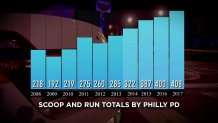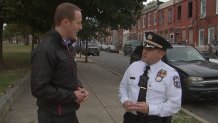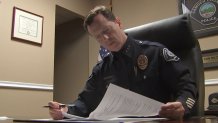What to Know
- Among cities with highest homicide rates, Philadelphia is the only one where police rush gunshot and stab wound victims to trauma centers.
- Last year, police drove 408 gunshot victims to Philadelphia trauma centers, according to the Pennsylvania Trauma Systems Foundation.
- Beyond its life-saving potential, some say scoop and run could enhance public safety in communities with broad distrust of police.
EDITOR'S NOTE: Elizabeth Van Brocklin is a staff reporter at The Trace. This story was published through a partnership between The Trace and NBC Philadelphia.
Ian Hirst-Hermans lay on the ground bleeding from a gunshot wound to his chest. He had been shot after leaving a house party just after 2 a.m. Within seconds, as he remembers, a police car came racing down the one-way North Philadelphia street in the wrong direction. Two cops jumped out and, with the help of his friend, lifted Hirst-Hermans into the back.
Blood pooled beneath the 20-year-old on the hard plastic backseat. He was sure he was going to die. Then from the front of the car came a calming voice. One of the officers was asking him questions about his college classes, telling him he was going to make it. Hirst-Hermans’ last memory of the drive was the siren of an ambulance blaring past and one of the officers saying, “There goes your ride.”
Had he been shot in another city, Hirst-Hermans might have died. The bullet hit a major artery in his chest, and he’d lost a lot of blood. A surgeon later told him that he’d made it to the hospital with less than a minute to spare.
Among cities with the highest rates of homicide, Philadelphia is the only one where police routinely rush gunshot and stab wound victims to the nearest trauma center instead of waiting for an ambulance. The practice — known as “scoop and run” or “scoop and go” — is deeply entrenched among the city’s law enforcement officers, who focus their patrol in areas with the highest instances of violent crime and, as a result, frequently beat EMS to crime scenes.
“The sense has always been, get that person to the hospital quick,” says John Stanford, a captain and 16-year veteran of the Police Department. “It’s just something you do.”
Local
Breaking news and the stories that matter to your neighborhood.
Last year, a third of Philadelphia’s 1,223 shooting victims were delivered to a city trauma center in the back of a police cruiser or wagon. At Temple University Hospital, the busiest hospital for gunshot patients in the state, about 70 percent of victims of penetrating trauma arrive by police vehicle or private vehicle, or simply walk in.
Scoop and Runs on Philadelphia Streets
Six out of every 100 trauma victims in the city of Philadelphia in the first half of 2018 arrived at the hospital by police vehicle. Here are some of the "scoops" seen via SEPTA police body cameras. (The victims in these videos have been blurred to protect their identity.)
Though Philadelphia police receive basic training on treating gunshot wounds, including how to apply a tourniquet, most of the victims they transport receive little or no medical care until they’re through the hospital doors. The practice challenges how most people think victims should be cared for. Yet trauma doctors in the city are effusive about scoop and run, and believe it saves lives. “Patients often survive the initial gunshot, but unfortunately a large number of them bleed out fairly quickly, within seconds and minutes,” says Marcin Jankowski, the head of trauma and surgical critical care at Hahnemann University Hospital, one of the city’s eight trauma centers. Doctors say the faster these patients can get to a trauma center, the better their chances at survival.
“Philadelphia is unique. The police have definitely taken ownership of getting patients to us as quickly as possible,” he adds.
Beyond its life-saving potential, some say scoop and run could enhance public safety in communities with broad distrust of police. When officers lift victims into the backseats of their cars, they become true first responders, shifting roles from enforcer to guardian, from soldier to protector.
As intuitive as scoop and run is among Philadelphia cops, police departments in other cities have little appetite for the practice. They argue that cops have other important responsibilities, like solving crimes; they lack the advanced medical training required of EMTs and paramedics; and there could be liability issues when victims don’t survive.
In certain circumstances, police in other cities already embrace scoop and run. Reports from the scenes of mass shootings include numerous examples of officers rushing victims to the hospital. And departments surveyed by The Trace and NBC Philadelphia pointed to another exception: Cops sometimes rush their wounded colleagues to the hospital.
Research suggests cities should consider innovative transport methods for all shooting victims. A recent national study found that the rate of gunshot victims who died en route to the hospital quadrupled between 2007 and 2014. “Their injuries are so severe that by the time they come to us, it’s very difficult to save their life,” says Joseph Sakran, the study’s author and a trauma surgeon at The Johns Hopkins Hospital in Baltimore.
After the two Philadelphia cops delivered Ian Hirst-Hermans to Temple’s trauma center that night eight years ago, surgeons got to work, removing an artery from his thigh to replace the destroyed one in his chest. He awoke the next day shaken. But his mood brightened when the two officers who scooped him came to visit. One joked that Hirst-Hermans needed to hurry up and get well so he could clean the blood out of their car.
Hirst-Hermans texts the officers every holiday season to thank them for getting him to the hospital. A few years ago, he had their last names tattooed in thick black cursive beneath his clavicle. “They’re my heroes,” he says. “I’m eternally grateful to those guys."
In Philadelphia, scoop and run is such a long-held tradition that many officers can’t imagine their jobs without it. “It was just something that was understood, that getting the person to the hospital was part of your duties,” says Kevin Bethel, a retired former deputy police commissioner who joined the department in the mid-eighties. Steven Davidson, a retired emergency physician and former EMS medical director for Philadelphia, remembers being a medical student in 1973 at Temple. He recalls how police would “put the victim of violence on a stretcher, throw ’em on the floor of the police van, and drive like crazy to the hospital.”
Last year, police drove 408 gunshot victims to Philadelphia trauma centers, according to the Pennsylvania Trauma Systems Foundation, the state’s accrediting agency for trauma centers. In the past decade, police scoop and runs of gunshot victims have nearly doubled, even as shootings have remained fairly level. The practice has become so common, one Level I trauma center recently designated a drop-off lane for cop cars. Officials say that even when a Philadelphia police officer shoots a civilian, another officer will scoop them.

Davidson helped lead one of the first systematic evaluations of scoop and run, a 1995 study that compared mortality rates of assault victims transported by police to those driven by medics. The researchers found no significant differences in survival. A year later, the Philadelphia Police Department formalized its policy, which instructs officers to transport gunshot and stabbing victims and not wait for EMS. In the years since, research on the city’s practice has reached similar conclusions.
The studies are far from perfect — they did not control for transport times or medical interventions in the field — but many clinicians interpret the findings to mean police transport is safe for patients, and in some cases advantageous.
One citywide study included a subset of people severely injured by gunshots. Compared to those transported by EMS, patients ferried by police had higher rates of surviving their wounds.
Philly police interviewed by The Trace and NBC Philadelphia consider scoop and run a natural part of their role. The only protective gear they carry are medical gloves; they expect to get bloody. “We don’t join the Police Department to watch people die,” says Stephen Clark, a captain for the 24th District, which has seen some of the highest numbers of shootings in the city.
To residents on the other end of a scoop and run, its logic may be less obvious. Rather than being tended to by trained EMTs and paramedics with a range of medical supplies and equipment, they are hoisted into the back of police cars, where they may not even receive direct pressure to their wounds, not to mention a buckled seat belt. “You hitting bumps, you bleeding, your body’s going all over the place,” says Terry Starks, who was transported by a cop after being shot five times in 2002. Philadelphia officials say that, to the best of their knowledge, neither the Police Department nor the city have been sued over police transport of victims. The Trace identified two civil lawsuits brought against the city by individual families who alleged the actions of police — including transporting and not applying pressure — contributed to their sons’ deaths. Neither went to trial.
According to some trauma doctors, the lack of medical intervention that victims receive during the typical scoop and run is part of what makes the practice beneficial. Advanced procedures like breathing tubes and IV fluids, while helpful for certain kinds of patients, may actually do more harm than good for shooting and stabbing victims in urban areas.
“I’d love to debunk the myth that you need a person on the scene who has all this advanced medical training and that is going to make the difference for this specific kind of injury,” says Elliott Haut, a Johns Hopkins trauma surgeon. For a presentation he gives at conferences, he shows a slide that asks what’s the best fluid to give victims of penetrating trauma. Then he clicks to the next slide, which reads “diesel fuel.” Haut says, “Yes, you’re going to get less medical care on the street and in the back of the car, but I’m OK with that because the shorter time is going to make a difference.”
Fire Commissioner Adam Thiel, who oversees the city’s EMTs and paramedics, says his ranks share a mutual understanding with the police when it comes to gunshot patients. “Based on the medical evidence, the goal of our entire public safety enterprise is to get those penetrating trauma patients to the nearest trauma center,” he says — regardless of whether that’s in an ambulance or a cruiser. And with the hundreds of thousands of medical and fire calls his department responds to each year, “everything helps.”

To understand how other cities regard scoop and run, The Trace and NBC Philadelphia surveyed police departments in more than a dozen cities with the highest homicide rates in the country. While several police departments have policies permitting their officers to conduct transports — including Chicago, Detroit, and Stockton, California — none reported transporting victims on a regular basis.
“Culture eats policy for lunch,” says Rick Myers, executive director of the Major Cities Chiefs Association, which represents the largest law enforcement agencies in the United States and Canada. “The culture of the organization, the ‘this-is-how-we-do-stuff-around-here,’ is a far more powerful factor in behavior than what’s stuck up on the wall.”
In Cleveland, a directive gives officers the option to transport a victim after assessing “the totality of the circumstances (e.g., location of incident, proximity of a hospital, proximity of EMS, nature of injury).” Officers found themselves weighing those factors last winter when they discovered a gunshot victim in Euclid, a suburb just beyond Cleveland’s city limits. He’d been shot 16 times. In footage captured by a responding officer’s body cam, the victim lies on a snowbank, his face blurred out. Lights from police vehicles strobe as officers ask him questions and count his wounds. He groans and begs to be taken to a hospital.
A minute passes, then another. No sign of EMS. At one point Euclid patrolmen use the victim’s belt to make a tourniquet for his leg. A third minute goes by — still nothing. “What are we waiting for?” asks one cop, her voice pitched with incredulity. “This kid needs a f------ hospital,” says another.
After four minutes, the officers decide to take the victim themselves. One drives and another sits in back, putting pressure on the victim’s wounds. They arrive in less than two minutes.
The man survived, and a local columnist hailed scoop-and-run as “a life-saving procedure for which police fail to get nearly enough credit.” But in a subsequent op-ed, a representative of the city’s paramedic and EMT union attributed the incident to dispatch confusion between the two cities, and argued that Cleveland residents would not benefit from “a Philadelphia-style police transport program.” Among his reasons, he pointed out that Philadelphia has five adult Level I trauma centers all within close proximity, while Cleveland has just two on opposite sides of town.
Police departments in Memphis and Cincinnati cited other reasons for not regularly practicing scoop and run, arguing that EMS units are better trained to handle severely injured patients. The New Orleans Police Department says its first priority is to secure the scene — hard to do if they’re speeding to the hospital. Philadelphia cops would dispute that; they see a public safety benefit to scoop and run.“Part of our transporting people helps decrease civil unrest,” said Verdell Johnson, a Philadelphia police inspector, at a recent trauma conference. “When we get out there and we have a shooting victim, if he’s shot by another person, it’s really chaotic, so we get them out of there.”
Myers, the chiefs association director, questioned the wisdom of devoting resources to training police to scoop, especially “at a time when we’re trying to train our officers to be better at de-escalation, reducing the use of force, be better communicators, get out of their cars and develop a relationship with community members to develop more trust.”
Neighborhoods with disproportionately high gun violence are often the same places where residents fear and distrust the police. The tension can make both law enforcement and residents skeptical of scoop and run. In Sacramento, where the killing of an unarmed 22-year-old by officers in March became yet another public symbol of police brutality against young black men, a spokesperson for the department said scoop and run could be “a big challenge because of the scrutiny right now.” Evin Johnson Sr., a gunshot survivor who works with other victims in the city, echoed the sentiment. “I don’t think the community would receive that well,” he said. “[Cops] don’t care if you die, they just want the information for who shot you.”
Philadelphia experiences the same dynamics — in April, two black men waiting for a friend in Starbucks were arrested for trespassing. “I can tell you about times where there’s a victim in the back of my car and every other word is an expletive to us. ‘F you, I’m not snitching, punk-ass cop,’” says Stanford, the Philadelphia captain. “And I’m still driving like a bat out of hell to get this guy to the hospital to save his life.”
Some scoop and run proponents hypothesize that having an officer spirit you or a loved one to the hospital at a life-or-death moment might have an unexplored power to help mend trust between police and residents of high-crime neighborhoods. “Being able to say to the community, here are instances when police have saved the lives of these frequently young victims of gun violence, I think is another justification for doing this,” says Jim Bueermann, president of the National Police Foundation, a policing innovation nonprofit.
Bueermann speaks about scoop and run in existential terms. “On this issue,” he says, “the Philadelphia Police Department is directly connected to the spirituality of policing” — the point of police work, to protect and serve. “The things cops see day in and day out are frequently negative,” he adds. “Having an opportunity to save a life in the performance of their duties gives officers a tremendous emotional boost.” Still, he thinks that more widespread adoption of scoop and run will require buy-in not just from police chiefs, but also city managers, city attorneys, mayors, and other local leaders. “Doesn’t mean you’re going to mandate it, but you have to allow in your policy, practice, training, messaging, and culture that if the officers do this, they’re not going to get in trouble.”
A few weeks ago in Philadelphia, Penn Medicine hosted a conference at which clinicians held a debate and panel on police transport for trauma victims. Dan Holena, a trauma surgeon at Penn Presbyterian Medical Center, conceded that scoop and run would probably not work in certain places, like cities with a lower concentration of trauma centers. “I can think of a half a dozen major U.S. cities where this could work and really should work, and the only reason that it’s not are things” — like local policies, culture, and legal concerns — “that really don’t have to do with care of the patient.”

Officials in Camden, New Jersey, decided to take a chance on scoop and run a few years ago. The chief of police, Scott Thomson, had gotten the idea from the city’s neighbor, Philadelphia, and hoped it would help build cops’ credibility among residents.
At first, some officers were wary. “Anytime, you implement something new and fundamentally different, there’s hesitation and some folks resist,” Thomson says. But he says they came around, and now his officers scoop about one in every five of Camden’s gunshot and stab wound victims. In a few cases, officers even transported victims who were shooting directly at them.
“The streets are always watching,” Thomson says. “And they see your behavior, and actions speak far louder than words.”



